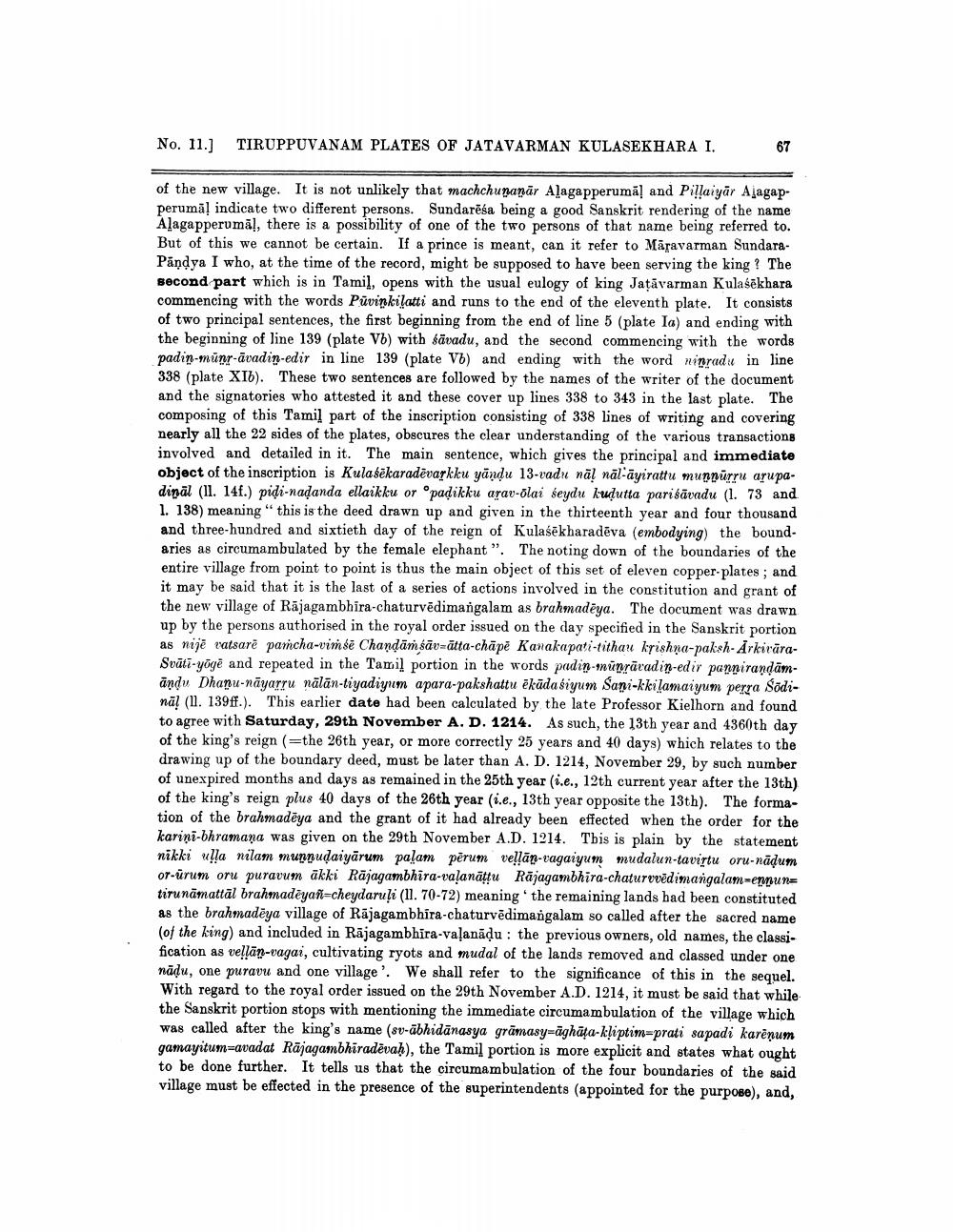________________
No. 11.]
of the new village. It is not unlikely that machchunanar Alagapperumal and Pillaiyar Ajagapperumal indicate two different persons. Sundaresa being a good Sanskrit rendering of the name Alagapperumal, there is a possibility of one of the two persons of that name being referred to. But of this we cannot be certain. If a prince is meant, can it refer to Maravarman SundaraPandya I who, at the time of the record, might be supposed to have been serving the king? The second part which is in Tamil, opens with the usual eulogy of king Jaṭāvarman Kulasekhara commencing with the words Puvinkilatti and runs to the end of the eleventh plate. It consists of two principal sentences, the first beginning from the end of line 5 (plate Ia) and ending with the beginning of line 139 (plate Vb) with savadu, and the second commencing with the words padin-munr-āvadin-edir in line 139 (plate V6) and ending with the word ninradu in line 338 (plate XIb). These two sentences are followed by the names of the writer of the document and the signatories who attested it and these cover up lines 338 to 343 in the last plate. The composing of this Tamil part of the inscription consisting of 338 lines of writing and covering nearly all the 22 sides of the plates, obscures the clear understanding of the various transactions involved and detailed in it. The main sentence, which gives the principal and immediate object of the inscription is Kulasekaradevarkku yandu 13-vadu nal nal-ayirattu munnurru arupadinal (11. 14f.) pidi-nadanda ellaikku or padikku arav-olai seydu kudutta parisävadu (1. 73 and 1. 138) meaning" this is the deed drawn up and given in the thirteenth year and four thousand and three-hundred and sixtieth day of the reign of Kulasekharadeva (embodying) the boundaries as circumambulated by the female elephant". The noting down of the boundaries of the entire village from point to point is thus the main object of this set of eleven copper-plates; and it may be said that it is the last of a series of actions involved in the constitution and grant of the new village of Rajagambhira-chaturvedimangalam as brahmadeya. The document was drawn up by the persons authorised in the royal order issued on the day specified in the Sanskrit portion as nije vatsare pamcha-vimse Chandamṣāv-atta-chāpē Kanakapati-tithau krishna-paksh- ArkivaraSvati-yōge and repeated in the Tamil portion in the words padin-munrävadin-edir pannirandamandu Dhanu-nayarru nälän-tiyadiyum apara-pakshattu ēkādasiyum Sani-kkilamaiyum perra Sõdinal (11. 139ff.). This earlier date had been calculated by the late Professor Kielhorn and found to agree with Saturday, 29th November A. D. 1214. As such, the 13th year and 4360th day of the king's reign (=the 26th year, or more correctly 25 years and 40 days) which relates to the drawing up of the boundary deed, must be later than A. D. 1214, November 29, by such number of unexpired months and days as remained in the 25th year (i.e., 12th current year after the 13th) of the king's reign plus 40 days of the 26th year (i.e., 13th year opposite the 13th). The formation of the brahmadeya and the grant of it had already been effected when the order for the kariņi-bhramana was given on the 29th November A.D. 1214. This is plain by the statement nikki ulla nilam munnudaiyarum palam perum vellan-vagaiyum mudalun-taviṛtu oru-nāḍum or-urum oru puravum äkki Rajagambhira-valanaṭṭu Rajagambhira-chaturvvedimangalam-ennun tirunamattal brahmadeyan-cheydaruli (11. 70-72) meaning the remaining lands had been constituted as the brahmadeya village of Rajagambhira-chaturvedimangalam so called after the sacred name (of the king) and included in Rajagambhira-valanāḍu: the previous owners, old names, the classification as vellan-vagai, cultivating ryots and mudal of the lands removed and classed under one nādu, one puravu and one village'. We shall refer to the significance of this in the sequel. With regard to the royal order issued on the 29th November A.D. 1214, it must be said that while the Sanskrit portion stops with mentioning the immediate circumambulation of the village which was called after the king's name (sv-abhidānasya grāmasy-aghata-kliptim-prati sapadi karēņum gamayitum avadat Rajagambhiradevaḥ), the Tamil portion is more explicit and states what ought to be done further. It tells us that the circumambulation of the four boundaries of the said village must be effected in the presence of the superintendents (appointed for the purpose), and,
TIRUPPUVANAM PLATES OF JATAVARMAN KULASEKHARA I.
67




